Edinburgh Science Festival Connecting Arts with Science to Take Place This Month
The event runs now through April 24th.

The arts and sciences are often seen as disparate practices, but they are closer cousins than many may think: from tales of scientific discovery littered throughout history to the countless artists who have taken inspiration from the romance and mystery of the cosmos. This year's Edinburgh Science Festival is dedicated to showing the many ways in which the arts and sciences are interconnected - two sides of the same coin often learning from one another to reach deeper connection and collective enlightenment - and to providing a platform for creatives to showcase their work.
Amanda Tyndall, Festival and Creative Director at Edinburgh Science said: "Art and science are both highly creative endeavours and the Festival each year aims to celebrate this creativity and the people that make it possible, connecting audiences with important science topics in innovative ways to deliver not just facts but emotional connections."
Summerhall once again plays host as the Festival's main arts hub, showcasing the best exhibitions and events in the world of STEAM. Elemental by Bright Side Studios makes a welcome return, inviting audiences to interact with the elements on a magical, immersive multisensory exploration of the theory of the elements. Supported by Cirrus Logic, Culture & Business Fund Scotland and Scottish Government's Festivals Expo Fund.
The ambitious Bioverse, a visual arts exhibition taking over Summerhall, includes Black Box is a curatorial cinema project, founded by artist, Louise Mackenzie and scientist, Kasia Pirog. This year, they are presenting a 90-minute programme of short films on the theme of kinship, exploring the different forms of relation that begin with the body, from viral and cellular interactions to the familial relationships affected by genetic disease. Also part of Bioverse are exhibitions: G-Lands, looking at research helping restore salivary gland function in cancer patient and Rooted Sea, exploring the endangered coastal ecosystems and wetlands of Scotland and India.
City Art Centre is home to a variety of exciting artistic offerings, including You Are Here, an exciting creation from Ray Interactive that creates a magic window to the sky, showing how the beguiling patterns of constellations can evoke fingerprints, radio waves or even microscopic life. A new work from Edinburgh-based artist Theodore Koterwas, Somewhere in the Universe it Rains Diamonds presents an Artificial Intelligence that was trained on the handwriting of astronomers and tirelessly scrawls data from these wondrous stellar events onto a dusty wall of graphite. Both exhibitions are supported by Creative Scotland through the Scottish Government Festivals Expo Fund, Cirrus Logic and Culture & Business Fund Scotland.
In The Elementalists: We Are Building a New World, another Edinburgh-based artist John Brown, using the idea of a periodic table and multiple paintings as a format, imagines a group of people constructing and exploring individual elements that are components of a bigger picture.
Art also finds its way into the exhibition programme with the DATASPHERE exhibition at the National Museum of Scotland featuring artwork by Scottish artists Alan Brown and Silent Chaos, both supported by PLACE (Platforms for Creative Excellence Programme) funding.
Every human being has become a living set of data and a potential content creator. Thanks to Silent Chaos, the Museum's Grand Gallery becomes a bespoke information collector, gathering data from the people visiting and the activities occurring here, via a network of different sensors, which are distributed around the space and visualised live on this screen. Looking at genetics and time, both from a scientific perspective and that of a lived experience, Alan Brown's Biological Clock changes every second to show the letters A, G, C & T which represent the molecules that make up a DNA sequence. The alarm clocks are varied with each representing the sequence of a different person. When the clock changes, the base letter is converted into sound.
In the wider programme, The Edinburgh Conservation Film Festival screens a selection of short films from around the world that will inspire, engage, and inform you about some of the multitude of projects helping to protect the world's biodiversity. Folklore, Fable and Facts explores how stories have been used to explain the world around us and spin order from the chaos of experience, from the cosmologies of the ancient world to the encoding of natural lore and historical events in folksong. Sensational Stories of Science brings together creative science communicators from a range of fields at Voodoo Rooms to tell tales of fantastic discoveries, astonishing feats of genius and the marvellous, tragic and the fascinating lives of the men and women who made them.
Over at the Royal Botanic Garden Edinburgh, audiences will be able to enjoy Seeing the Invisible, the first exhibition of its kind to be developed in collaboration between botanical gardens and art institutions from around the world and featuring 13 augmented reality (AR) works by artists including: Ai Weiwei, Isaac Julien CBE, Daito Manabe, El Anatsui and Refik Anadol. This fascinating exhibition focuses on our relationship with nature and explore the boundaries and connections between art, technology, and nature. The venue also presents A Rose By Any Other Name, coinciding with the peak flowering period of RBGE's rhododendrons, this exhibition reveals our significant history of collecting, researching and cultivating this genus. The exhibition also includes work by contemporary artists, historical botanical illustration, photography and objects from our archive.
|
Facebook | Twitter | Instagram | YouTube
|
Comments
Videos

